EST200 Assignment 1: Child Development Theories and Media
VerifiedAdded on 2023/04/07
|9
|2240
|54
Essay
AI Summary
This essay delves into the behaviors of children and adolescents as portrayed in the media, analyzing these representations through the lens of various developmental theories. It explores how these behaviors are shaped by different learning styles and the significant impact of sociocultural influences on a child's learning and development process. The essay incorporates insights from prominent theorists like Freud, Skinner, and Vygotsky, examining how their frameworks explain the changes and challenges children face. It also addresses issues children encounter in school and society, such as peer pressure, emotional difficulties, and the influence of media, while highlighting the role of parents, teachers, and counselors in fostering positive development. The essay covers cognitive, affective, and psychomotor domains of learning, as well as the importance of creating suitable learning environments. Finally, it emphasizes the interconnectedness of individual development and social processes and the effect of culture and language on human development, concluding with a synthesis of these influences on a child's behavior and learning outcomes.
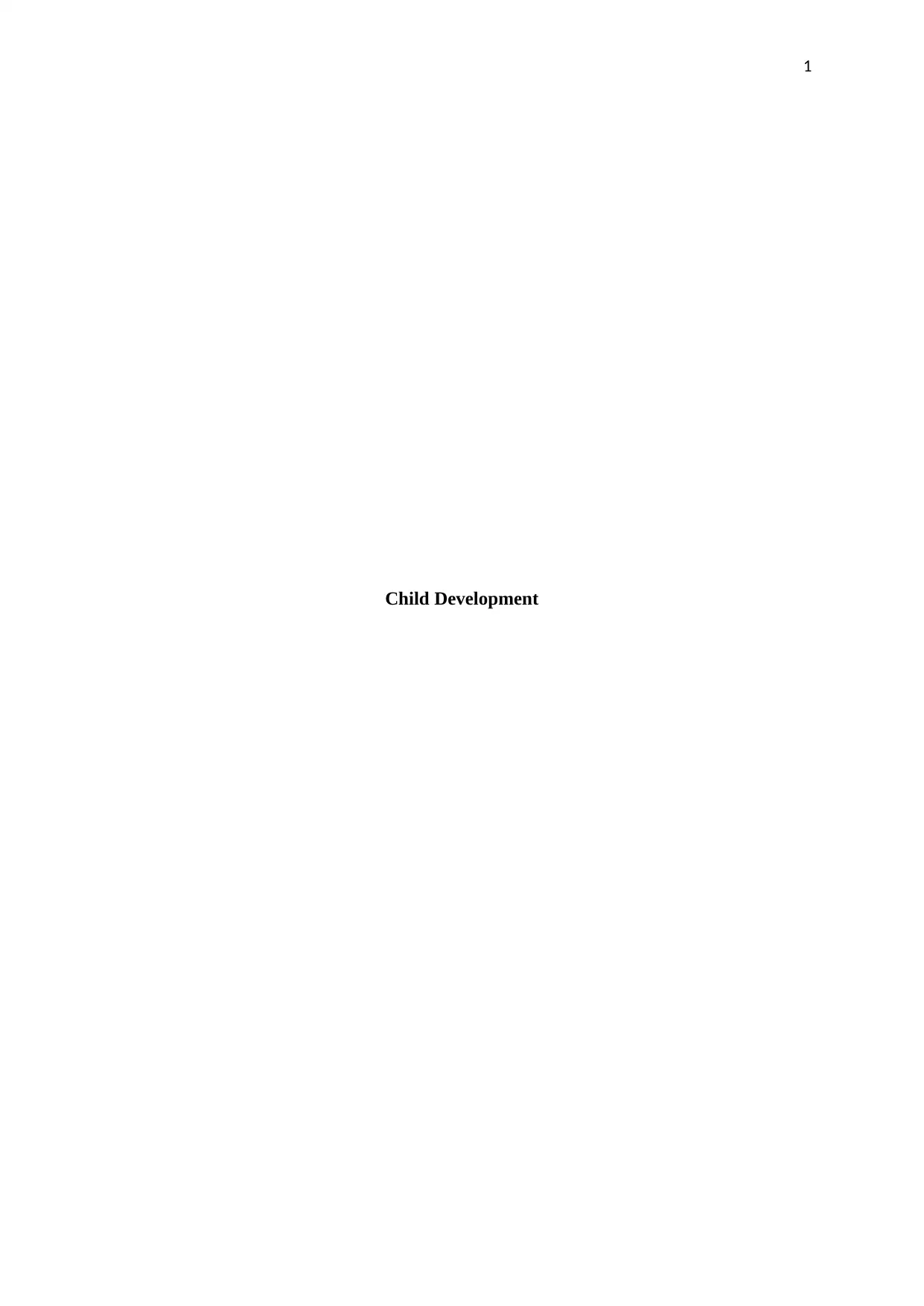
1
Child Development
Child Development
Paraphrase This Document
Need a fresh take? Get an instant paraphrase of this document with our AI Paraphraser
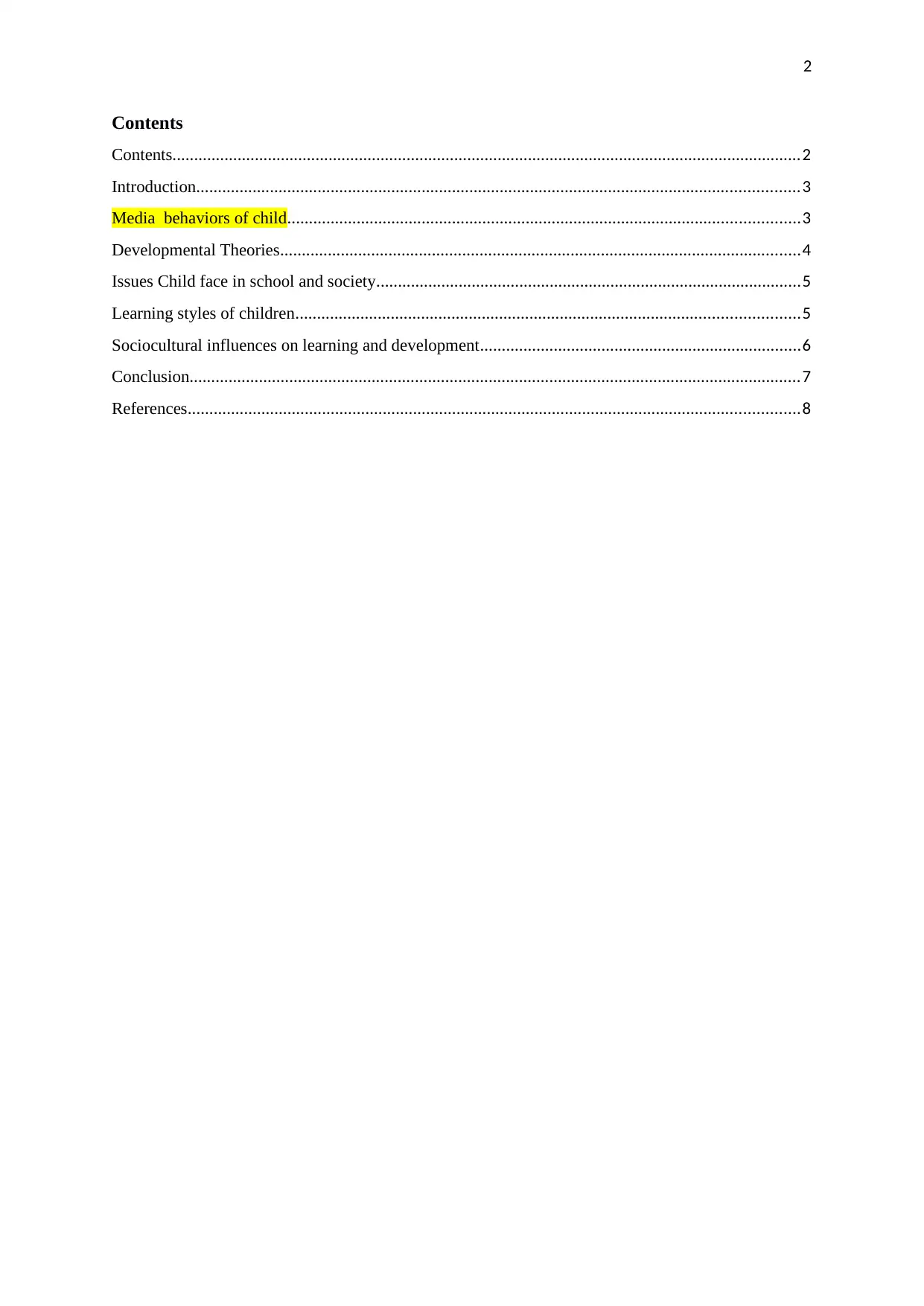
2
Contents
Contents.................................................................................................................................................2
Introduction...........................................................................................................................................3
Media behaviors of child......................................................................................................................3
Developmental Theories........................................................................................................................4
Issues Child face in school and society..................................................................................................5
Learning styles of children....................................................................................................................5
Sociocultural influences on learning and development..........................................................................6
Conclusion.............................................................................................................................................7
References.............................................................................................................................................8
Contents
Contents.................................................................................................................................................2
Introduction...........................................................................................................................................3
Media behaviors of child......................................................................................................................3
Developmental Theories........................................................................................................................4
Issues Child face in school and society..................................................................................................5
Learning styles of children....................................................................................................................5
Sociocultural influences on learning and development..........................................................................6
Conclusion.............................................................................................................................................7
References.............................................................................................................................................8
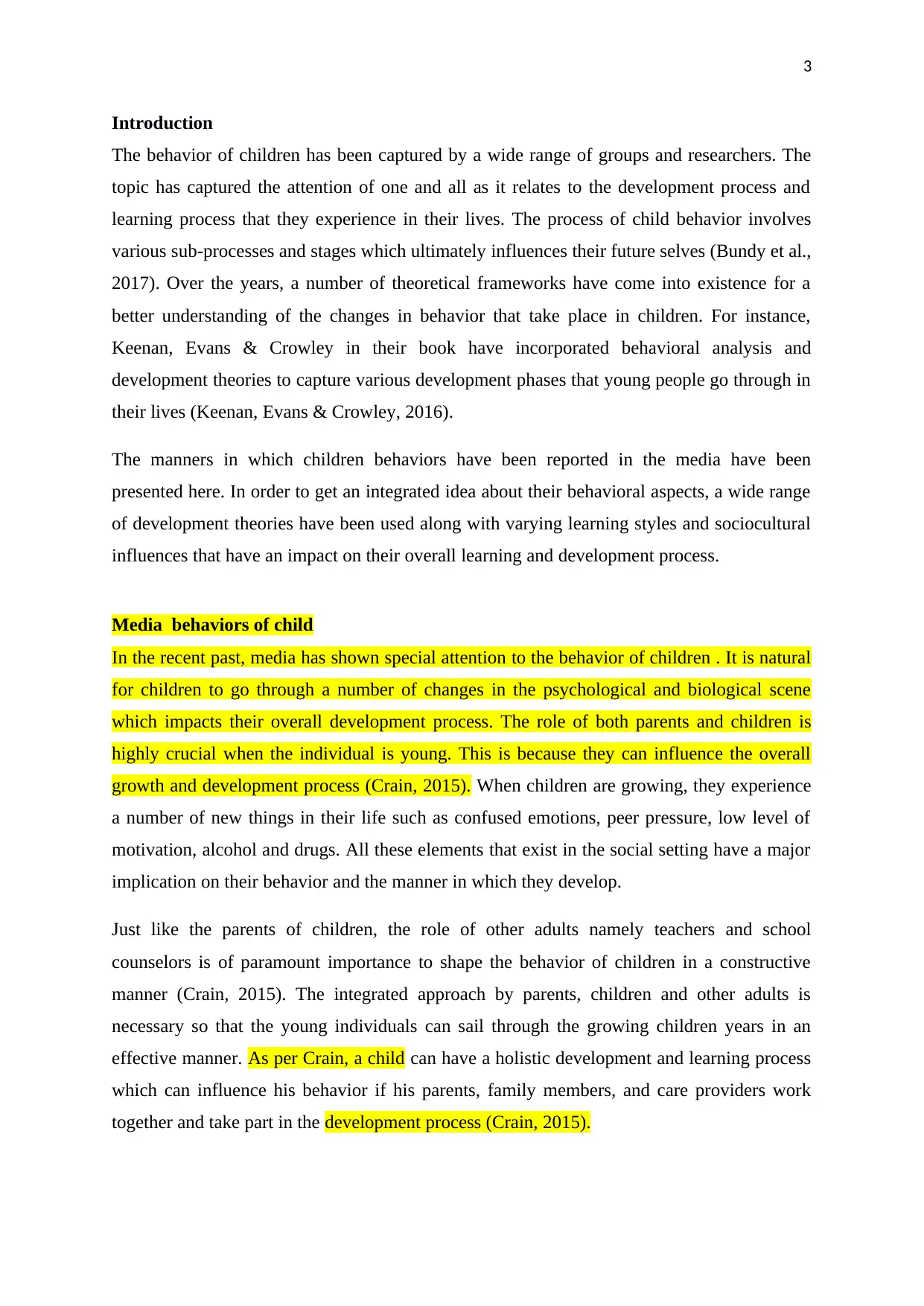
3
Introduction
The behavior of children has been captured by a wide range of groups and researchers. The
topic has captured the attention of one and all as it relates to the development process and
learning process that they experience in their lives. The process of child behavior involves
various sub-processes and stages which ultimately influences their future selves (Bundy et al.,
2017). Over the years, a number of theoretical frameworks have come into existence for a
better understanding of the changes in behavior that take place in children. For instance,
Keenan, Evans & Crowley in their book have incorporated behavioral analysis and
development theories to capture various development phases that young people go through in
their lives (Keenan, Evans & Crowley, 2016).
The manners in which children behaviors have been reported in the media have been
presented here. In order to get an integrated idea about their behavioral aspects, a wide range
of development theories have been used along with varying learning styles and sociocultural
influences that have an impact on their overall learning and development process.
Media behaviors of child
In the recent past, media has shown special attention to the behavior of children . It is natural
for children to go through a number of changes in the psychological and biological scene
which impacts their overall development process. The role of both parents and children is
highly crucial when the individual is young. This is because they can influence the overall
growth and development process (Crain, 2015). When children are growing, they experience
a number of new things in their life such as confused emotions, peer pressure, low level of
motivation, alcohol and drugs. All these elements that exist in the social setting have a major
implication on their behavior and the manner in which they develop.
Just like the parents of children, the role of other adults namely teachers and school
counselors is of paramount importance to shape the behavior of children in a constructive
manner (Crain, 2015). The integrated approach by parents, children and other adults is
necessary so that the young individuals can sail through the growing children years in an
effective manner. As per Crain, a child can have a holistic development and learning process
which can influence his behavior if his parents, family members, and care providers work
together and take part in the development process (Crain, 2015).
Introduction
The behavior of children has been captured by a wide range of groups and researchers. The
topic has captured the attention of one and all as it relates to the development process and
learning process that they experience in their lives. The process of child behavior involves
various sub-processes and stages which ultimately influences their future selves (Bundy et al.,
2017). Over the years, a number of theoretical frameworks have come into existence for a
better understanding of the changes in behavior that take place in children. For instance,
Keenan, Evans & Crowley in their book have incorporated behavioral analysis and
development theories to capture various development phases that young people go through in
their lives (Keenan, Evans & Crowley, 2016).
The manners in which children behaviors have been reported in the media have been
presented here. In order to get an integrated idea about their behavioral aspects, a wide range
of development theories have been used along with varying learning styles and sociocultural
influences that have an impact on their overall learning and development process.
Media behaviors of child
In the recent past, media has shown special attention to the behavior of children . It is natural
for children to go through a number of changes in the psychological and biological scene
which impacts their overall development process. The role of both parents and children is
highly crucial when the individual is young. This is because they can influence the overall
growth and development process (Crain, 2015). When children are growing, they experience
a number of new things in their life such as confused emotions, peer pressure, low level of
motivation, alcohol and drugs. All these elements that exist in the social setting have a major
implication on their behavior and the manner in which they develop.
Just like the parents of children, the role of other adults namely teachers and school
counselors is of paramount importance to shape the behavior of children in a constructive
manner (Crain, 2015). The integrated approach by parents, children and other adults is
necessary so that the young individuals can sail through the growing children years in an
effective manner. As per Crain, a child can have a holistic development and learning process
which can influence his behavior if his parents, family members, and care providers work
together and take part in the development process (Crain, 2015).
⊘ This is a preview!⊘
Do you want full access?
Subscribe today to unlock all pages.

Trusted by 1+ million students worldwide
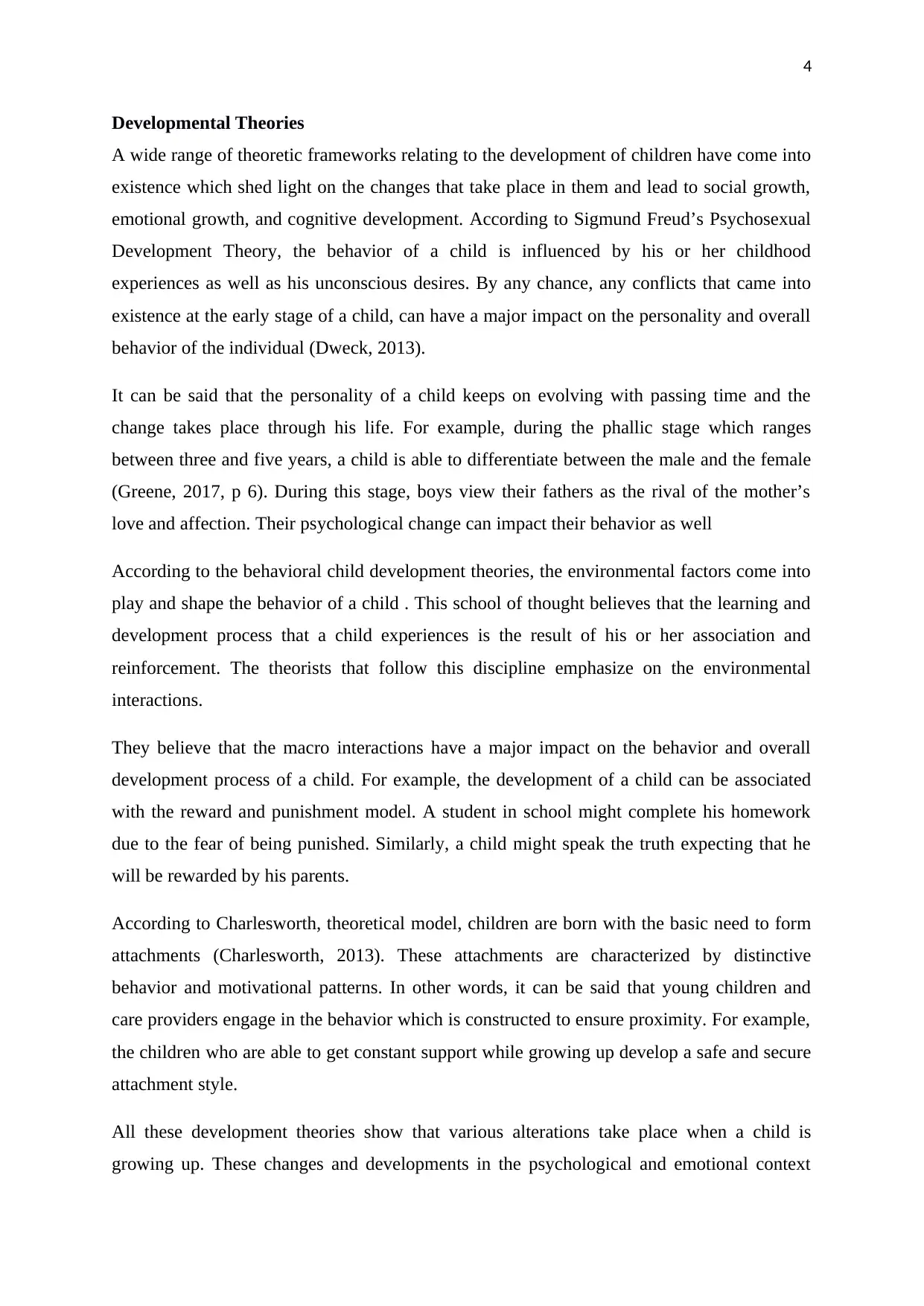
4
Developmental Theories
A wide range of theoretic frameworks relating to the development of children have come into
existence which shed light on the changes that take place in them and lead to social growth,
emotional growth, and cognitive development. According to Sigmund Freud’s Psychosexual
Development Theory, the behavior of a child is influenced by his or her childhood
experiences as well as his unconscious desires. By any chance, any conflicts that came into
existence at the early stage of a child, can have a major impact on the personality and overall
behavior of the individual (Dweck, 2013).
It can be said that the personality of a child keeps on evolving with passing time and the
change takes place through his life. For example, during the phallic stage which ranges
between three and five years, a child is able to differentiate between the male and the female
(Greene, 2017, p 6). During this stage, boys view their fathers as the rival of the mother’s
love and affection. Their psychological change can impact their behavior as well
According to the behavioral child development theories, the environmental factors come into
play and shape the behavior of a child . This school of thought believes that the learning and
development process that a child experiences is the result of his or her association and
reinforcement. The theorists that follow this discipline emphasize on the environmental
interactions.
They believe that the macro interactions have a major impact on the behavior and overall
development process of a child. For example, the development of a child can be associated
with the reward and punishment model. A student in school might complete his homework
due to the fear of being punished. Similarly, a child might speak the truth expecting that he
will be rewarded by his parents.
According to Charlesworth, theoretical model, children are born with the basic need to form
attachments (Charlesworth, 2013). These attachments are characterized by distinctive
behavior and motivational patterns. In other words, it can be said that young children and
care providers engage in the behavior which is constructed to ensure proximity. For example,
the children who are able to get constant support while growing up develop a safe and secure
attachment style.
All these development theories show that various alterations take place when a child is
growing up. These changes and developments in the psychological and emotional context
Developmental Theories
A wide range of theoretic frameworks relating to the development of children have come into
existence which shed light on the changes that take place in them and lead to social growth,
emotional growth, and cognitive development. According to Sigmund Freud’s Psychosexual
Development Theory, the behavior of a child is influenced by his or her childhood
experiences as well as his unconscious desires. By any chance, any conflicts that came into
existence at the early stage of a child, can have a major impact on the personality and overall
behavior of the individual (Dweck, 2013).
It can be said that the personality of a child keeps on evolving with passing time and the
change takes place through his life. For example, during the phallic stage which ranges
between three and five years, a child is able to differentiate between the male and the female
(Greene, 2017, p 6). During this stage, boys view their fathers as the rival of the mother’s
love and affection. Their psychological change can impact their behavior as well
According to the behavioral child development theories, the environmental factors come into
play and shape the behavior of a child . This school of thought believes that the learning and
development process that a child experiences is the result of his or her association and
reinforcement. The theorists that follow this discipline emphasize on the environmental
interactions.
They believe that the macro interactions have a major impact on the behavior and overall
development process of a child. For example, the development of a child can be associated
with the reward and punishment model. A student in school might complete his homework
due to the fear of being punished. Similarly, a child might speak the truth expecting that he
will be rewarded by his parents.
According to Charlesworth, theoretical model, children are born with the basic need to form
attachments (Charlesworth, 2013). These attachments are characterized by distinctive
behavior and motivational patterns. In other words, it can be said that young children and
care providers engage in the behavior which is constructed to ensure proximity. For example,
the children who are able to get constant support while growing up develop a safe and secure
attachment style.
All these development theories show that various alterations take place when a child is
growing up. These changes and developments in the psychological and emotional context
Paraphrase This Document
Need a fresh take? Get an instant paraphrase of this document with our AI Paraphraser
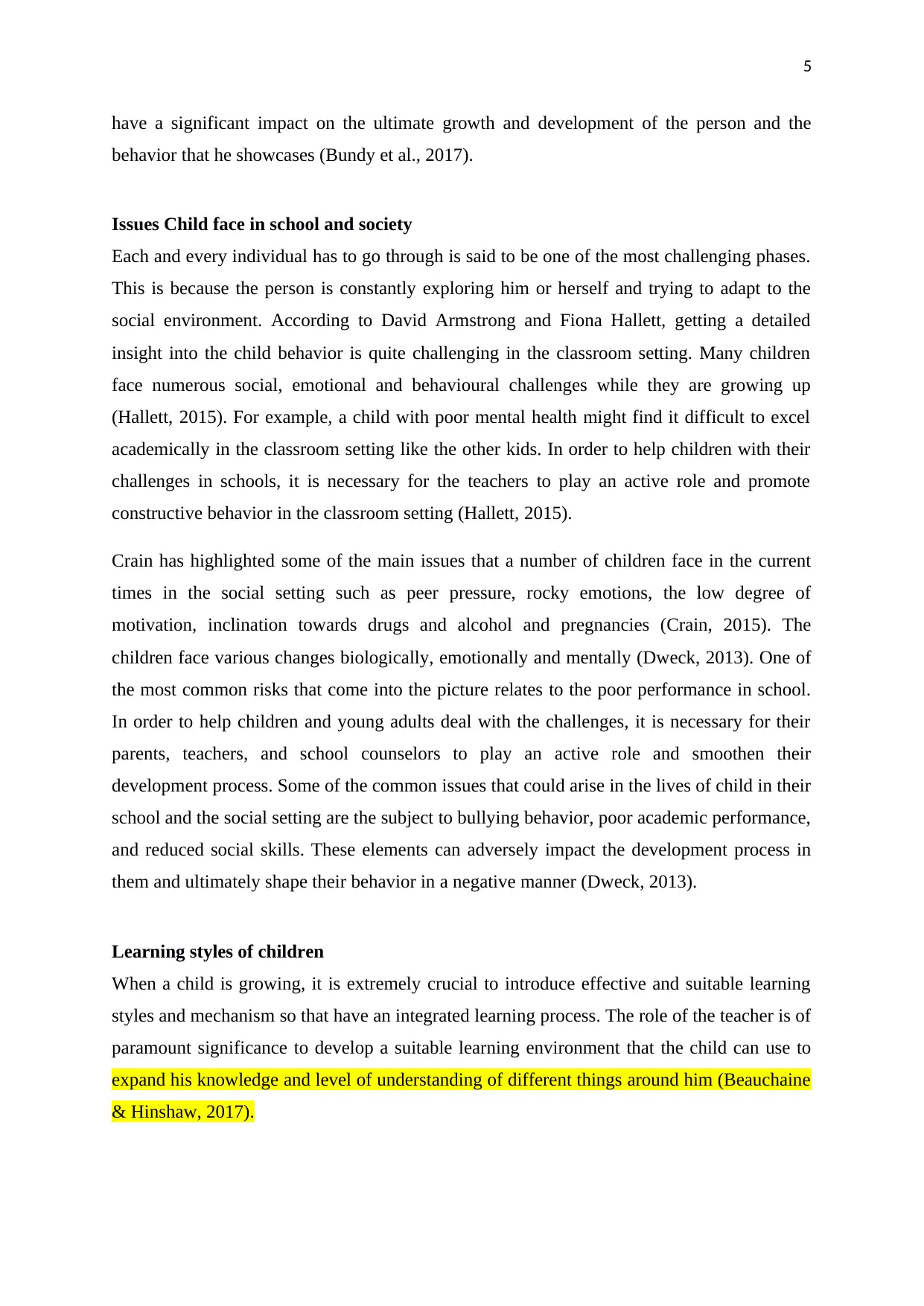
5
have a significant impact on the ultimate growth and development of the person and the
behavior that he showcases (Bundy et al., 2017).
Issues Child face in school and society
Each and every individual has to go through is said to be one of the most challenging phases.
This is because the person is constantly exploring him or herself and trying to adapt to the
social environment. According to David Armstrong and Fiona Hallett, getting a detailed
insight into the child behavior is quite challenging in the classroom setting. Many children
face numerous social, emotional and behavioural challenges while they are growing up
(Hallett, 2015). For example, a child with poor mental health might find it difficult to excel
academically in the classroom setting like the other kids. In order to help children with their
challenges in schools, it is necessary for the teachers to play an active role and promote
constructive behavior in the classroom setting (Hallett, 2015).
Crain has highlighted some of the main issues that a number of children face in the current
times in the social setting such as peer pressure, rocky emotions, the low degree of
motivation, inclination towards drugs and alcohol and pregnancies (Crain, 2015). The
children face various changes biologically, emotionally and mentally (Dweck, 2013). One of
the most common risks that come into the picture relates to the poor performance in school.
In order to help children and young adults deal with the challenges, it is necessary for their
parents, teachers, and school counselors to play an active role and smoothen their
development process. Some of the common issues that could arise in the lives of child in their
school and the social setting are the subject to bullying behavior, poor academic performance,
and reduced social skills. These elements can adversely impact the development process in
them and ultimately shape their behavior in a negative manner (Dweck, 2013).
Learning styles of children
When a child is growing, it is extremely crucial to introduce effective and suitable learning
styles and mechanism so that have an integrated learning process. The role of the teacher is of
paramount significance to develop a suitable learning environment that the child can use to
expand his knowledge and level of understanding of different things around him (Beauchaine
& Hinshaw, 2017).
have a significant impact on the ultimate growth and development of the person and the
behavior that he showcases (Bundy et al., 2017).
Issues Child face in school and society
Each and every individual has to go through is said to be one of the most challenging phases.
This is because the person is constantly exploring him or herself and trying to adapt to the
social environment. According to David Armstrong and Fiona Hallett, getting a detailed
insight into the child behavior is quite challenging in the classroom setting. Many children
face numerous social, emotional and behavioural challenges while they are growing up
(Hallett, 2015). For example, a child with poor mental health might find it difficult to excel
academically in the classroom setting like the other kids. In order to help children with their
challenges in schools, it is necessary for the teachers to play an active role and promote
constructive behavior in the classroom setting (Hallett, 2015).
Crain has highlighted some of the main issues that a number of children face in the current
times in the social setting such as peer pressure, rocky emotions, the low degree of
motivation, inclination towards drugs and alcohol and pregnancies (Crain, 2015). The
children face various changes biologically, emotionally and mentally (Dweck, 2013). One of
the most common risks that come into the picture relates to the poor performance in school.
In order to help children and young adults deal with the challenges, it is necessary for their
parents, teachers, and school counselors to play an active role and smoothen their
development process. Some of the common issues that could arise in the lives of child in their
school and the social setting are the subject to bullying behavior, poor academic performance,
and reduced social skills. These elements can adversely impact the development process in
them and ultimately shape their behavior in a negative manner (Dweck, 2013).
Learning styles of children
When a child is growing, it is extremely crucial to introduce effective and suitable learning
styles and mechanism so that have an integrated learning process. The role of the teacher is of
paramount significance to develop a suitable learning environment that the child can use to
expand his knowledge and level of understanding of different things around him (Beauchaine
& Hinshaw, 2017).
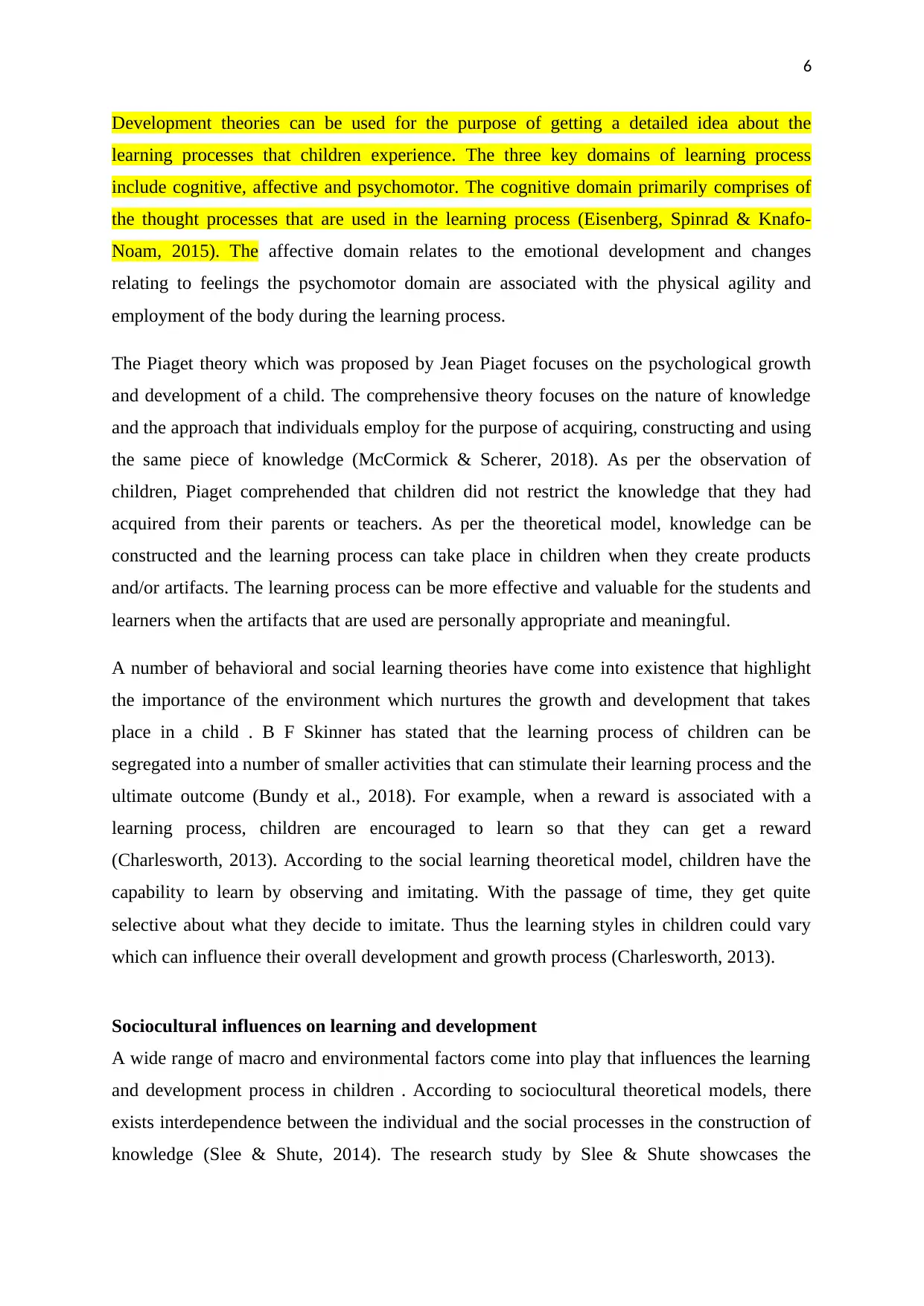
6
Development theories can be used for the purpose of getting a detailed idea about the
learning processes that children experience. The three key domains of learning process
include cognitive, affective and psychomotor. The cognitive domain primarily comprises of
the thought processes that are used in the learning process (Eisenberg, Spinrad & Knafo‐
Noam, 2015). The affective domain relates to the emotional development and changes
relating to feelings the psychomotor domain are associated with the physical agility and
employment of the body during the learning process.
The Piaget theory which was proposed by Jean Piaget focuses on the psychological growth
and development of a child. The comprehensive theory focuses on the nature of knowledge
and the approach that individuals employ for the purpose of acquiring, constructing and using
the same piece of knowledge (McCormick & Scherer, 2018). As per the observation of
children, Piaget comprehended that children did not restrict the knowledge that they had
acquired from their parents or teachers. As per the theoretical model, knowledge can be
constructed and the learning process can take place in children when they create products
and/or artifacts. The learning process can be more effective and valuable for the students and
learners when the artifacts that are used are personally appropriate and meaningful.
A number of behavioral and social learning theories have come into existence that highlight
the importance of the environment which nurtures the growth and development that takes
place in a child . B F Skinner has stated that the learning process of children can be
segregated into a number of smaller activities that can stimulate their learning process and the
ultimate outcome (Bundy et al., 2018). For example, when a reward is associated with a
learning process, children are encouraged to learn so that they can get a reward
(Charlesworth, 2013). According to the social learning theoretical model, children have the
capability to learn by observing and imitating. With the passage of time, they get quite
selective about what they decide to imitate. Thus the learning styles in children could vary
which can influence their overall development and growth process (Charlesworth, 2013).
Sociocultural influences on learning and development
A wide range of macro and environmental factors come into play that influences the learning
and development process in children . According to sociocultural theoretical models, there
exists interdependence between the individual and the social processes in the construction of
knowledge (Slee & Shute, 2014). The research study by Slee & Shute showcases the
Development theories can be used for the purpose of getting a detailed idea about the
learning processes that children experience. The three key domains of learning process
include cognitive, affective and psychomotor. The cognitive domain primarily comprises of
the thought processes that are used in the learning process (Eisenberg, Spinrad & Knafo‐
Noam, 2015). The affective domain relates to the emotional development and changes
relating to feelings the psychomotor domain are associated with the physical agility and
employment of the body during the learning process.
The Piaget theory which was proposed by Jean Piaget focuses on the psychological growth
and development of a child. The comprehensive theory focuses on the nature of knowledge
and the approach that individuals employ for the purpose of acquiring, constructing and using
the same piece of knowledge (McCormick & Scherer, 2018). As per the observation of
children, Piaget comprehended that children did not restrict the knowledge that they had
acquired from their parents or teachers. As per the theoretical model, knowledge can be
constructed and the learning process can take place in children when they create products
and/or artifacts. The learning process can be more effective and valuable for the students and
learners when the artifacts that are used are personally appropriate and meaningful.
A number of behavioral and social learning theories have come into existence that highlight
the importance of the environment which nurtures the growth and development that takes
place in a child . B F Skinner has stated that the learning process of children can be
segregated into a number of smaller activities that can stimulate their learning process and the
ultimate outcome (Bundy et al., 2018). For example, when a reward is associated with a
learning process, children are encouraged to learn so that they can get a reward
(Charlesworth, 2013). According to the social learning theoretical model, children have the
capability to learn by observing and imitating. With the passage of time, they get quite
selective about what they decide to imitate. Thus the learning styles in children could vary
which can influence their overall development and growth process (Charlesworth, 2013).
Sociocultural influences on learning and development
A wide range of macro and environmental factors come into play that influences the learning
and development process in children . According to sociocultural theoretical models, there
exists interdependence between the individual and the social processes in the construction of
knowledge (Slee & Shute, 2014). The research study by Slee & Shute showcases the
⊘ This is a preview!⊘
Do you want full access?
Subscribe today to unlock all pages.

Trusted by 1+ million students worldwide
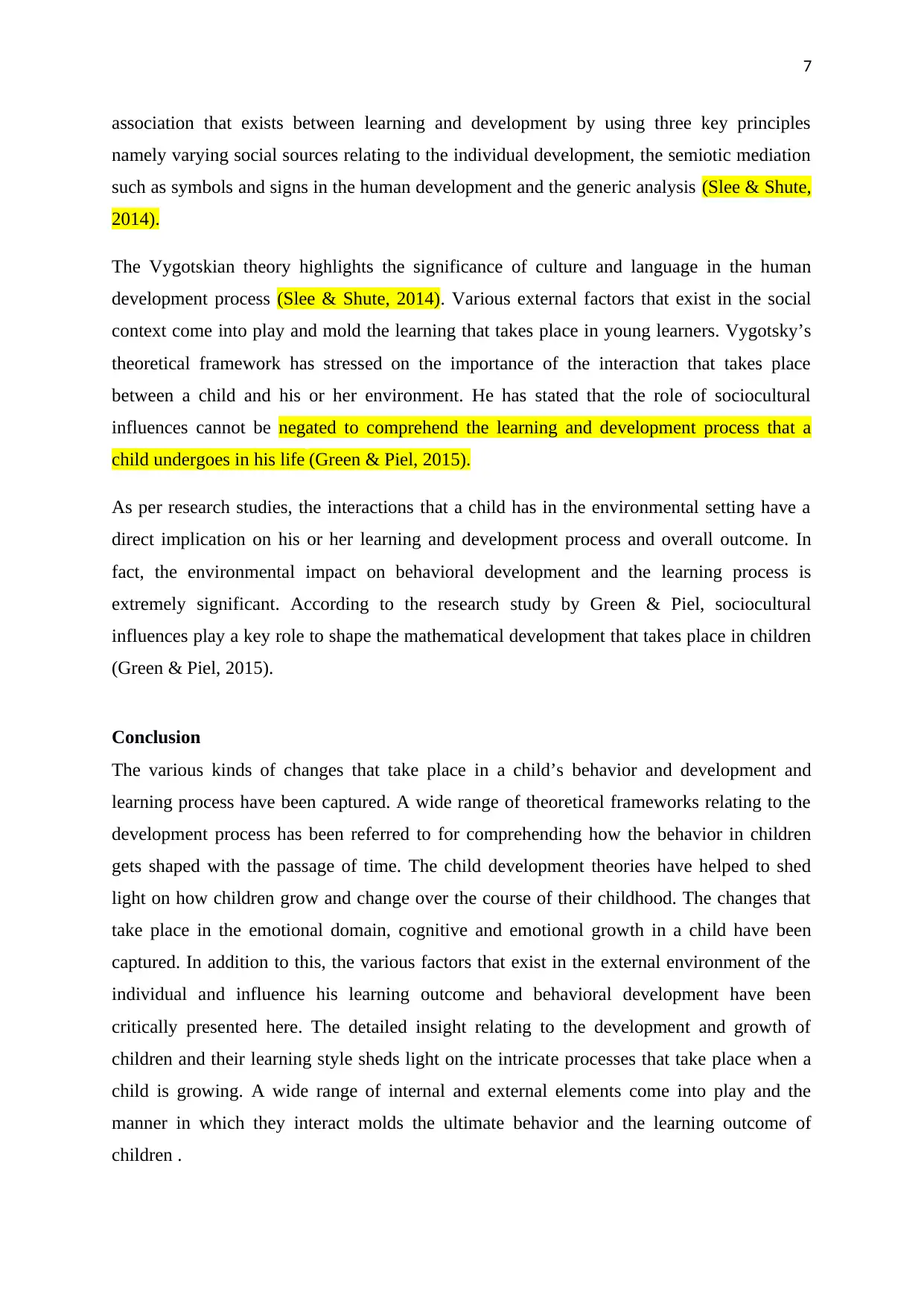
7
association that exists between learning and development by using three key principles
namely varying social sources relating to the individual development, the semiotic mediation
such as symbols and signs in the human development and the generic analysis (Slee & Shute,
2014).
The Vygotskian theory highlights the significance of culture and language in the human
development process (Slee & Shute, 2014). Various external factors that exist in the social
context come into play and mold the learning that takes place in young learners. Vygotsky’s
theoretical framework has stressed on the importance of the interaction that takes place
between a child and his or her environment. He has stated that the role of sociocultural
influences cannot be negated to comprehend the learning and development process that a
child undergoes in his life (Green & Piel, 2015).
As per research studies, the interactions that a child has in the environmental setting have a
direct implication on his or her learning and development process and overall outcome. In
fact, the environmental impact on behavioral development and the learning process is
extremely significant. According to the research study by Green & Piel, sociocultural
influences play a key role to shape the mathematical development that takes place in children
(Green & Piel, 2015).
Conclusion
The various kinds of changes that take place in a child’s behavior and development and
learning process have been captured. A wide range of theoretical frameworks relating to the
development process has been referred to for comprehending how the behavior in children
gets shaped with the passage of time. The child development theories have helped to shed
light on how children grow and change over the course of their childhood. The changes that
take place in the emotional domain, cognitive and emotional growth in a child have been
captured. In addition to this, the various factors that exist in the external environment of the
individual and influence his learning outcome and behavioral development have been
critically presented here. The detailed insight relating to the development and growth of
children and their learning style sheds light on the intricate processes that take place when a
child is growing. A wide range of internal and external elements come into play and the
manner in which they interact molds the ultimate behavior and the learning outcome of
children .
association that exists between learning and development by using three key principles
namely varying social sources relating to the individual development, the semiotic mediation
such as symbols and signs in the human development and the generic analysis (Slee & Shute,
2014).
The Vygotskian theory highlights the significance of culture and language in the human
development process (Slee & Shute, 2014). Various external factors that exist in the social
context come into play and mold the learning that takes place in young learners. Vygotsky’s
theoretical framework has stressed on the importance of the interaction that takes place
between a child and his or her environment. He has stated that the role of sociocultural
influences cannot be negated to comprehend the learning and development process that a
child undergoes in his life (Green & Piel, 2015).
As per research studies, the interactions that a child has in the environmental setting have a
direct implication on his or her learning and development process and overall outcome. In
fact, the environmental impact on behavioral development and the learning process is
extremely significant. According to the research study by Green & Piel, sociocultural
influences play a key role to shape the mathematical development that takes place in children
(Green & Piel, 2015).
Conclusion
The various kinds of changes that take place in a child’s behavior and development and
learning process have been captured. A wide range of theoretical frameworks relating to the
development process has been referred to for comprehending how the behavior in children
gets shaped with the passage of time. The child development theories have helped to shed
light on how children grow and change over the course of their childhood. The changes that
take place in the emotional domain, cognitive and emotional growth in a child have been
captured. In addition to this, the various factors that exist in the external environment of the
individual and influence his learning outcome and behavioral development have been
critically presented here. The detailed insight relating to the development and growth of
children and their learning style sheds light on the intricate processes that take place when a
child is growing. A wide range of internal and external elements come into play and the
manner in which they interact molds the ultimate behavior and the learning outcome of
children .
Paraphrase This Document
Need a fresh take? Get an instant paraphrase of this document with our AI Paraphraser
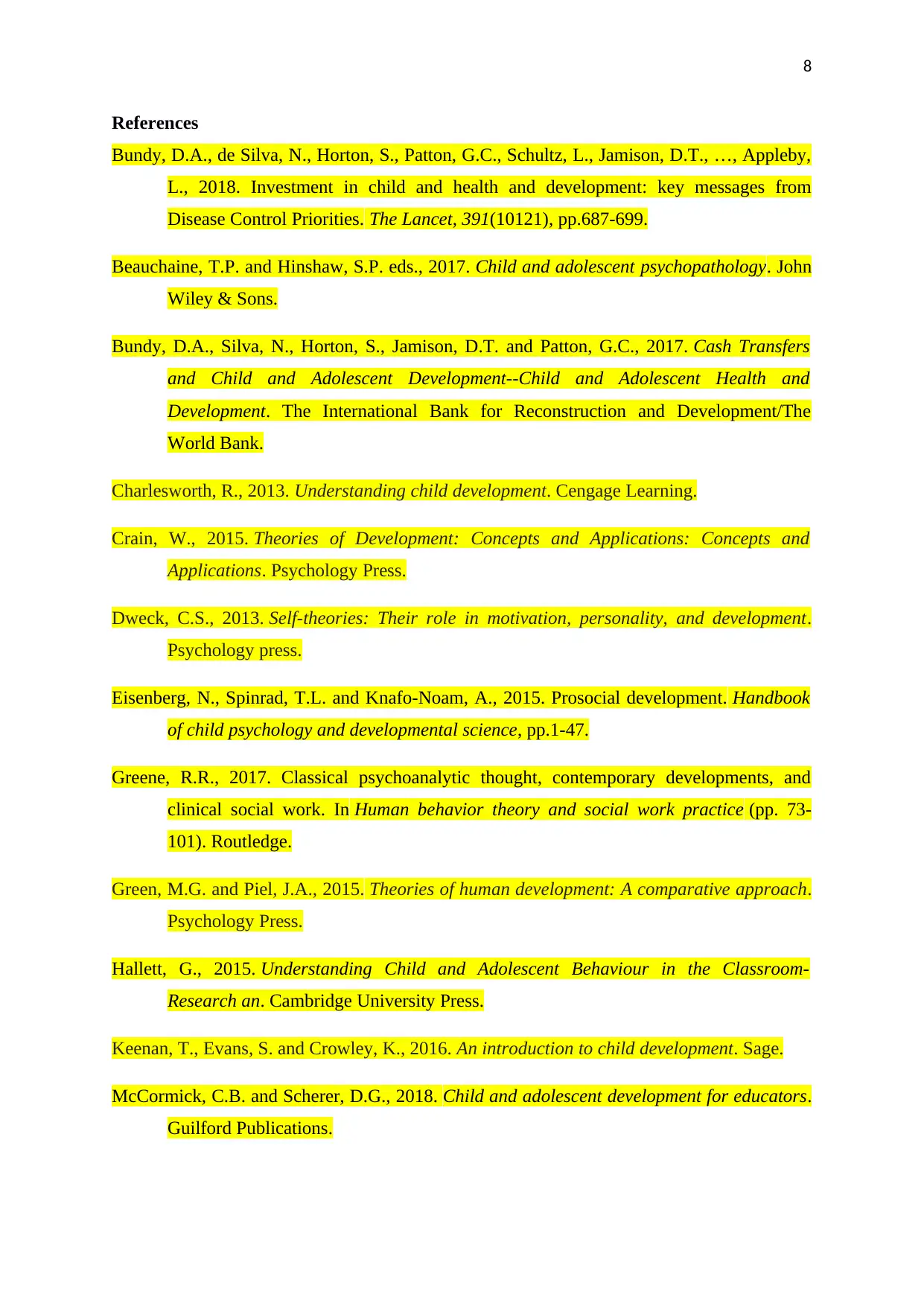
8
References
Bundy, D.A., de Silva, N., Horton, S., Patton, G.C., Schultz, L., Jamison, D.T., …, Appleby,
L., 2018. Investment in child and health and development: key messages from
Disease Control Priorities. The Lancet, 391(10121), pp.687-699.
Beauchaine, T.P. and Hinshaw, S.P. eds., 2017. Child and adolescent psychopathology. John
Wiley & Sons.
Bundy, D.A., Silva, N., Horton, S., Jamison, D.T. and Patton, G.C., 2017. Cash Transfers
and Child and Adolescent Development--Child and Adolescent Health and
Development. The International Bank for Reconstruction and Development/The
World Bank.
Charlesworth, R., 2013. Understanding child development. Cengage Learning.
Crain, W., 2015. Theories of Development: Concepts and Applications: Concepts and
Applications. Psychology Press.
Dweck, C.S., 2013. Self-theories: Their role in motivation, personality, and development.
Psychology press.
Eisenberg, N., Spinrad, T.L. and Knafo‐Noam, A., 2015. Prosocial development. Handbook
of child psychology and developmental science, pp.1-47.
Greene, R.R., 2017. Classical psychoanalytic thought, contemporary developments, and
clinical social work. In Human behavior theory and social work practice (pp. 73-
101). Routledge.
Green, M.G. and Piel, J.A., 2015. Theories of human development: A comparative approach.
Psychology Press.
Hallett, G., 2015. Understanding Child and Adolescent Behaviour in the Classroom-
Research an. Cambridge University Press.
Keenan, T., Evans, S. and Crowley, K., 2016. An introduction to child development. Sage.
McCormick, C.B. and Scherer, D.G., 2018. Child and adolescent development for educators.
Guilford Publications.
References
Bundy, D.A., de Silva, N., Horton, S., Patton, G.C., Schultz, L., Jamison, D.T., …, Appleby,
L., 2018. Investment in child and health and development: key messages from
Disease Control Priorities. The Lancet, 391(10121), pp.687-699.
Beauchaine, T.P. and Hinshaw, S.P. eds., 2017. Child and adolescent psychopathology. John
Wiley & Sons.
Bundy, D.A., Silva, N., Horton, S., Jamison, D.T. and Patton, G.C., 2017. Cash Transfers
and Child and Adolescent Development--Child and Adolescent Health and
Development. The International Bank for Reconstruction and Development/The
World Bank.
Charlesworth, R., 2013. Understanding child development. Cengage Learning.
Crain, W., 2015. Theories of Development: Concepts and Applications: Concepts and
Applications. Psychology Press.
Dweck, C.S., 2013. Self-theories: Their role in motivation, personality, and development.
Psychology press.
Eisenberg, N., Spinrad, T.L. and Knafo‐Noam, A., 2015. Prosocial development. Handbook
of child psychology and developmental science, pp.1-47.
Greene, R.R., 2017. Classical psychoanalytic thought, contemporary developments, and
clinical social work. In Human behavior theory and social work practice (pp. 73-
101). Routledge.
Green, M.G. and Piel, J.A., 2015. Theories of human development: A comparative approach.
Psychology Press.
Hallett, G., 2015. Understanding Child and Adolescent Behaviour in the Classroom-
Research an. Cambridge University Press.
Keenan, T., Evans, S. and Crowley, K., 2016. An introduction to child development. Sage.
McCormick, C.B. and Scherer, D.G., 2018. Child and adolescent development for educators.
Guilford Publications.
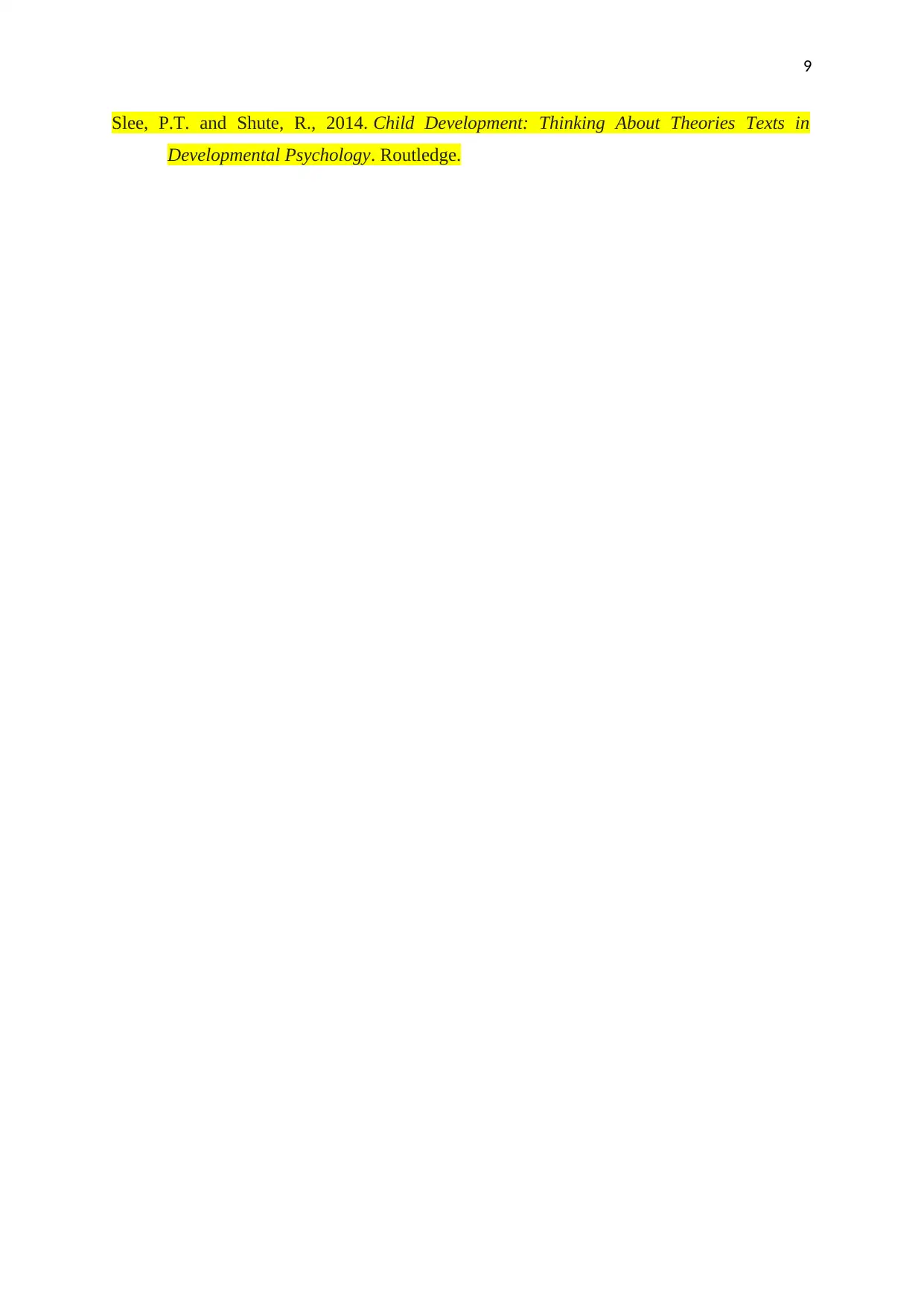
9
Slee, P.T. and Shute, R., 2014. Child Development: Thinking About Theories Texts in
Developmental Psychology. Routledge.
Slee, P.T. and Shute, R., 2014. Child Development: Thinking About Theories Texts in
Developmental Psychology. Routledge.
⊘ This is a preview!⊘
Do you want full access?
Subscribe today to unlock all pages.

Trusted by 1+ million students worldwide
1 out of 9
Related Documents
Your All-in-One AI-Powered Toolkit for Academic Success.
+13062052269
info@desklib.com
Available 24*7 on WhatsApp / Email
![[object Object]](/_next/static/media/star-bottom.7253800d.svg)
Unlock your academic potential
Copyright © 2020–2025 A2Z Services. All Rights Reserved. Developed and managed by ZUCOL.





